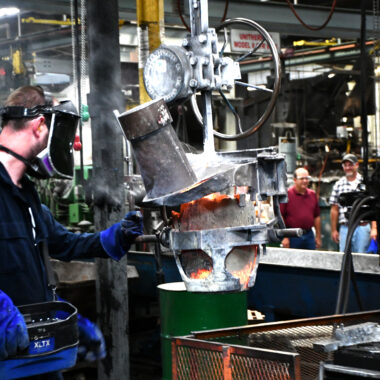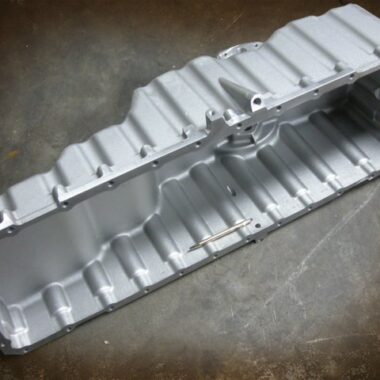Accuracy in Practice: The Art About Aluminum Casting
Accuracy in Practice: The Art About Aluminum Casting
Blog Article
Aluminum Spreading Mastery: Techniques and Devices for Exceptional Outcomes
Understanding the art of aluminum casting calls for a fragile balance of precision, technique, and the usage of specialized devices. As we explore the elaborate methods and devices included in light weight aluminum casting mastery, one can not neglect the relevance of sophisticated putting and cooling down methods that can elevate the final end result.

Value of Correct Melting Strategies
Utilizing specific temperature control during the melting procedure is critical in ensuring the high quality and honesty of aluminum spreadings. The melting of aluminum is an essential action in the spreading process, as it directly influences the final properties of the casted parts. Correct melting techniques are vital to attain the desired metallurgical structure, mechanical buildings, and surface finish of the aluminum elements.

Moreover, monitoring and changing the thaw temperature during the procedure aid avoid getting too hot, which can create grain growth and impact the total quality of the aluminum casting. Complying with accurate melting methods not just boosts the quality of the end product however likewise boosts the efficiency and cost-effectiveness of the casting process.
Critical Mold Preparation Steps
Proper preparation of mold and mildews is a basic element in the light weight aluminum spreading procedure, making certain the effective duplication of complex details and measurements in the last casted elements. Prior to pouring the molten aluminum, the mold and mildew tooth cavity should be thoroughly cleaned up and dried to protect against flaws in the casting.
Furthermore, correct gating and risering style are vital in mold prep work to make sure audio castings with marginal problems like porosity and shrinkage. Eviction system assists in the flow of molten steel into the mold and mildew tooth cavity, while risers aid protect against shrinkage by giving extra liquified metal as the spreading solidifies. Cautious factor to consider of these elements throughout mold preparation dramatically adds to the top quality and integrity of the last light weight aluminum cast components.
Advanced Pouring and Air Conditioning Approaches
Executing innovative pouring and cooling techniques is crucial in optimizing the light weight aluminum spreading procedure for enhanced efficiency and top quality outcomes. Utilizing methods such as vacuum cleaner spreading can dramatically decrease porosity in the end product, leading to improved mechanical buildings. By leaving the air from the mold cavity before pouring, the danger of gas entrapment is decreased, causing a denser and even more structurally audio spreading.
Additionally, utilizing controlled cooling methods, such read as water quenching or air cooling, can influence the material's microstructure and mechanical qualities (about aluminum casting). Rapid cooling can help attain better grain structures and boosted mechanical properties, making the cast aluminum preferable for applications needing high stamina and durability
Additionally, executing directional solidification strategies, where the spreading solidifies gradually from one end to another, can assist reduce interior flaws and improve general part honesty. By meticulously taking care of the temperature level differentials during solidification, the formation of contraction porosity and warm rips can be minimized, leading to higher quality castings with enhanced mechanical performance.
Crucial Tools for Aluminum Spreading
Enhancing the efficiency and quality results of aluminum spreading processes depends greatly on the usage of details devices made to maximize numerous aspects of the casting operation. One necessary device for light weight aluminum casting is the crucible. Crucibles are containers made of products like clay-graphite or silicon carbide that stand up to the high temperatures needed for melting light weight aluminum. Crucibles are available in different dimensions to suit various spreading volumes and are important for melting and pouring the molten light weight aluminum.
An additional essential tool is the mold and mildew. Mold and mildews can be made from products like sand, plaster, or metal and are used to shape the molten aluminum into the wanted type. about aluminum casting. Appropriate mold and mildew design and products are crucial for accomplishing precise casting measurements and surface go to website area coatings
Along with mold and mildews and crucibles, a heater is a fundamental device for light weight aluminum spreading. Heating systems heat the steel to its melting factor, guaranteeing it is in a state ready for spreading. Critical for maintaining regular temperature levels and ensuring the light weight aluminum continues to be liquified, furnaces are readily available in various kinds, such as electric, gas, or induction heaters, each with its benefits for specific casting demands.
Finishing Touches and Quality Checks
Upon completing the casting procedure, meticulous interest to finishing touches and extensive quality checks is critical to make sure the stability and accuracy of the aluminum parts - about aluminum casting. Completing touches entail the removal of any excess product, such as flash, gating systems, or harsh sides, to attain the desired last form and surface area top quality. This step typically includes processes like grinding, sanding, or fired blowing up to improve the look and structure of the actors parts
Quality checks are after that performed to validate that the parts satisfy the specific demands and requirements. These checks may involve dimensional examinations using accuracy devices like calipers or coordinate determining devices to make sure accuracy. Additionally, non-destructive testing techniques such as ultrasonic screening or X-ray examination can be utilized to identify any kind of internal flaws that may compromise the architectural integrity of the components.
Verdict
Finally, grasping aluminum spreading techniques and utilizing the right tools is necessary for achieving remarkable results. Appropriate melting strategies, mold and mildew prep work, putting and cooling down approaches, in addition to completing touches and high quality checks are critical action in the casting process. By adhering to these actions carefully and making use of the suitable tools, one can ensure a successful and top notch light weight aluminum spreading manufacturing.
As we discover the intricate strategies and tools entailed in light weight aluminum casting mastery, one can not neglect the relevance of sophisticated pouring discover here and cooling down techniques that can elevate the final result.Correct prep work of molds is a fundamental aspect in the aluminum casting process, making certain the successful replication of complex details and measurements in the last casted components. Prior to pouring the molten light weight aluminum, the mold and mildew cavity must be diligently cleaned and dried out to stop issues in the casting.Enhancing the effectiveness and top quality outcomes of aluminum spreading processes depends greatly on the application of details devices made to enhance different facets of the spreading operation.In addition to crucibles and mold and mildews, a furnace is a fundamental device for light weight aluminum spreading.
Report this page